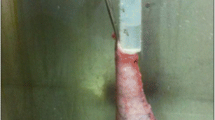Abstract
Background
Laparoscopic sleeve gastrectomy (LSG) is gaining popularity for the treatment of obesity. The objective of this study was to evaluate the volume of the resected stomach (VRS) as a predictor of the percentage of excess weight loss (%EWL) 1 year after LSG.
Methods
This was a single-surgeon study of prospectively collected data of patients who underwent LSG at Jordan University Hospital (February 2009 to February 2012). The VRS was measured using a standardized technique. The %EWL was calculated at 3, 6, and 12 months postoperatively. The correlation between the VRS and %EWL was statistically evaluated.
Results
Ninety patients underwent LSG during the study period. Of these, 73 patients (57 female) completed at least 1 year of follow-up and were analyzed; their body mass index was 45 ± 7.6 kg/m2 (33–81). The VRS was 1,337.4 ± 435.2 ml (600–2,800). The %EWL was 33.6 ± 11.1 % at 3 months, 48.6 ± 15.5 % at 6 months, and 56.8 ± 18.9 % at 12 months. A significant correlation was observed between the VRS and %EWL at 1 year (p = 0.003). Patients with a VRS of >1,100 ml (n = 43) achieved significantly greater %EWL at 12 months than did those with a VRS of ≤1,100 (n = 30). Removal of >1,100 ml of gastric volume was associated with a sensitivity and specificity of 75.5 and 46.2 %, respectively, for achieving a %EWL of ≥50 %.
Conclusion
The VRS can be used as an indicator of excess weight loss 1 year after LSG.


Similar content being viewed by others
References
Gagner M, Patterson E. Laparoscopic biliopancreatic diversion with duodenal switch. Dig Surg. 2000;17:547–66.
Regan JP, Inabnet WB, Gagner M. Early experience with two-stage laparoscopic Roux-en-Y gastric bypass as an alternative in the super-super obese patient. Obes Surg. 2003;13:861–4.
Baltasar A, Serra C, Perez N, et al. Laparoscopic sleeve gastrectomy: a multi-purpose bariatric operation. Obes Surg. 2005;15:1124–8.
Lee CM, Cirangle PT, Jossart GH. Vertical gastrectomy for morbid obesity in 216 patients: report of two-year results. Surg Endosc. 2007;21:1810–6.
Vidal P, Ramón JM, Busto M, et al. Residual gastric volume estimated with a new radiological volumetric model: relationship with weight loss after laparoscopic sleeve gastrectomy. Obes Surg. 2014;24(3):359–63.
Karamanakos SN, Vagenas K, Kalfarentzos F, et al. Weight loss, appetite suppression, and changes in fasting and postprandial ghrelin and peptide-YY levels after Roux-en-Y gastric bypass and sleeve gastrectomy. A prospective, double blind study. Ann Surg. 2008;247:401–7.
Braghetto I, Davanzo C, Korn O, et al. Scintigraphic evaluation of gastric emptying in obese patients submitted to sleeve gastrectomy compared to normal subjects. Obes Surg. 2009;19:1515–21.
Melissas J, Daskalakis M, Koukouraki S, et al. Sleeve gastrectomy—a “food limiting” operation. Obes Surg. 2008;18:1251–6.
Gagner M. Faster gastric emptying after laparoscopic sleeve gastrectomy. Obes Surg. 2010;20:964–5.
Michalsky D, Dvorak P, Belacek J, et al. Radical resection of the pyloric antrum and its effect on gastric emptying after sleeve gastrectomy. Obes Surg. 2013;23(4):567–73.
Deitel M, Gagner M, Erickson AL, et al. Third International Summit: current status of sleeve gastrectomy. Surg Obes Relat Dis. 2011;7(6):749–59.
Baraki YM, Traverso P, Elariny HA, et al. Preoperative prediction of stomach weight to be removed in laparoscopic sleeve gastrectomy procedure. Surg Technol Int. 2010;20:167–71.
NIH Conference. Gastrointestinal surgery for severe obesity. Consen- sus development conference panel. Ann Intern Med. 1991;115:956–61.
Alley JB et al. Quality of life after sleeve gastrectomy and adjustable gastric banding. Surg Obes Relat Dis. 2012.
Papailiou J, Albanopoulos K, Toutouzas KG, et al. Morbid obesity and sleeve gastrectomy: how does it work? Obes Surg. 2010;20:1448–55.
Parikh M, Gagner M, Heacock L. Laparoscopic sleeve gastrectomy: does bougie size affect mean %EWL? Short-term outcomes. Surg Obes Relat Dis. 2008;4:528–33.
Weiner RA, Weiner S, Pomhoff I, et al. Laparoscopic sleeve gastrectomy—influence of sleeve size and resected gastric volume. Obes Surg. 2007;17:1297–305.
Gagner M. Leaks after sleeve gastrectomy are associated with smaller bougies: prevention and treatment strategies. Surg Laparosc Endosc Percutan Tech. 2010;20(3):166–9.
Jacobs M, Bisland W, Gomez E, et al. Laparoscopic sleeve gastrectomy: a retrospective review of 1- and 2-years results. Surg Endosc. 2010;24:781–5.
Yehoshua RT, Eidelman LA, Stein M, et al. Laparoscopic sleeve gastrectomy—volume and pressure assessment. Obes Surg. 2008;18:1083–8.
Moon Han S, Kim WW, Oh JH. Results of laparoscopic sleeve gastrectomy (LSG) at 1 year in morbidly obese Korean patients. Obes Surg. 2005;15:1469–75.
Pomerri F, Foletto M, Allegro G, et al. Laparoscopic sleeve gastrectomy—radiological assessment of fundus size and sleeve voiding. Obes Surg. 2011;21:858–63.
Sabbagh C, Verhaeghe P, Dhahri A, et al. Two-year results on morbidity, weight loss and quality of life of sleeve gastrectomy as first procedure, sleeve gastrectomy after failure of gastric banding and gastric banding. Obes Surg. 2010;20:679–84.
Andersen JR et al. Predictors of weight loss are different in men and women after sleeve gastrectomy. Obes Surg. 2013.
Conflict of Interest
Firas W. Obeidat, Hiba A. Shanti, Ayman A. Mismar, Elmuhtaseb MS, and Mohammad S. Al-Qudah declare no conflict of interests.
Author information
Authors and Affiliations
Corresponding author
Rights and permissions
About this article
Cite this article
Obeidat, F.W., Shanti, H.A., Mismar, A.A. et al. Volume of Resected Stomach as a Predictor of Excess Weight Loss After Sleeve Gastrectomy. OBES SURG 24, 1904–1908 (2014). https://doi.org/10.1007/s11695-014-1330-y
Published:
Issue Date:
DOI: https://doi.org/10.1007/s11695-014-1330-y




